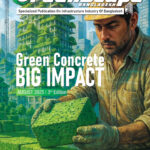Click Here for Media Coverage link
The main idea behind green construction is sustainability. Firstly, construction must take environmental issues into consideration so that the next generation does not suffer due to our actions. Secondly, structures have to be durable. Even if the environmental impact of a less durable structure is low, it can’t be considered sustainable. Thirdly, construction projects have to be affordable. And lastly, the use of construction materials has to be minimized.
If we want to boost green construction, we must adopt the concept of life-cycle analysis. According to life-cycle analysis, structures with a longer life are considered cheaper even if their monetary cost is slightly higher. The total maintenance cost throughout the life of a structure is included in the life-cycle costs. The concept of social cost analysis also has to be incorporated into the cost analysis of construction products. The environmental load of a construction product is added to the commodity value to give us the social cost. We are set to fail in achieving the relevant sustainable development goals (SDGs) by 2030 because we have yet to incorporate life-cycle and social cost analysis concepts into green construction.
Bangladesh’s carbon emission is about 100 million tones per year. If the construction sector is responsible for one-third of this emission, it means it emits 33 million tonnes. Of this, brick production alone contributes 20 million tones. Bangladesh has a commitment under the 2015 United Nations Climate Change Conference, COP 21, to reduce carbon emissions by 20 percent by 2030. If we stop using bricks as construction materials, we can reduce carbon emission by close to 20 percent. 300 grams of carbon emission are produced per kilogram of brick. But, concrete blocks only emit 100 grams of carbon per kilogram. Therefore, by shifting from bricks to concrete blocks, the entire sector can reduce two-thirds of the current carbon emissions.
One kilogram of cement is responsible for one kilogram of carbon emission. One kilogram of rod produces half a kilogram of carbon emission. Therefore, cement and rod consumption has to be reduced. We also have to reduce carbon emissions in the cement and rod production process by using advanced technology.
Stone aggregate, which is coarse aggregate, is a mandatory construction material that is fully imported. Green construction encourages the usage of local materials. Since there are no alternatives to stone aggregate, its use has to be decreased to be sustainable.
Ferro-cement technology can help reduce building material consumption and carbon emissions and increase affordability and structure durability.
Md Abu Sadeque,
PEng., Executive Director, HBRC








